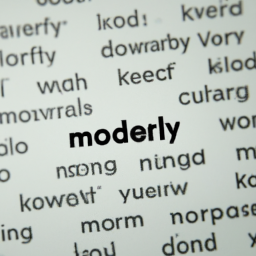Understanding Mozs Keyword Difficulty Metric to Improve SEO Results
Keyword Difficulty MOZ
Keyword Difficulty: SEO Tips to Conquer MOZ
If you can't make heads or tails out of the keyword difficulty MOZ, you're not alone. SEO can be overwhelming and all the nuances of organic search can quickly become overwhelming. However, understanding keyword difficulty and improving your SEO rankings can be simple if you know what to look for, and use the available tools. To get you started on the right foot, here are eight subtopics you can explore for in-depth insight into keyword MOZ understanding with key tips on improving your SEO rankings.
Features
The keyword difficulty MOZ' feature reflects the difficulty of ranking a keyword in organic search. The higher the number--usually between 0 and 100--the more difficult it could be to rank for the same. It also highlights possible opportunities to target long-tail and relevant keywords that have low difficulty.
Benefits
One of the biggest benefits to using MOZ's keyword tool is that it provides data-driven insights into keyword difficulty as it relates to organic search. This data can provide an overview of potential keywords to target, foolish moves to avoid, and ways to capitalize on SEO opportunities.
Pros & Cons
User-friendliness is one of the biggest pros of using MOZ for keyword research. Everything from the ability to do local research to industry-specific metrics makes it easier for novices and experienced SEOs alike to obtain the information they're looking for. On the negative side, MOZ can be expensive and, depending on what features you are looking to add, may be overkill.
Case Studies
To get an idea of how MOZ's keyword difficulty tool works, consider the following case studies:
- Case Study 1: A local business looking to decide on target keywords for a blog campaign in their industry
- Case Study 2: An e-commerce site's efforts to optimize landing pages for specific, targeted keywords
- Case Study 3: A company trying to improve the amount of organic traffic from a specific geographic region by focusing on local keywords
- Case Study 4: A business aiming to maximize their brand's awareness by targeting high-volume, low keyword difficulty keywords
Mistakes People Make
One of the most egregious errors businesses make with SEO is targeting a keyword with too high of difficulty. If you don't have the resources to complete a full SEO audit, your best bet is to target a keyword with a difficulty of less than 30. This is to make sure your efforts are not completely wasted and that you have a good chance of ranking for the keyword.
Best Practices
When researching keywords for SEO, it's essential to use a tool that shows more than the basic metrics. If you have the resources, MOZ is one of the best tools to use, as it provides detailed data about each keyword. This data gives you different metrics, such as keyword difficulty, to determine the likelihood of ranking for the given keyword and to optimize best for SEO.
FAQs
For those who are new to keyword research, here are some frequently asked questions about keyword difficulty MOZ:
- Q. What tools can be used to obtain keyword difficulty data?
- A. MOZ's keyword tool is the most popular tool used for obtaining keyword difficulty data.
- Q.How easy is it to use MOZ to find keyword difficulty data?
- A. MOz makes it easy to search for keywords and quickly find their difficulty level.
- Q. Are there any other tools that can provide keyword difficulty data?
- A. Yes, there are other tools, such as Ahrefs and SEMRush, which can provide keyword difficulty data.
Summary
When searching for keywords to use in an SEO campaign, using a tool like MOZ to obtain keyword difficulty data can be an essential part of the process. MOZ's easy-to-use keyword tool allows users to quickly find keyword difficulty as well as other metrics that can help in optimizing for SEO. While other tools may provide the same or similar functionality, MOZ is the most popular and widely used. By understanding keyword difficulty MOZ and following best SEO practices, businesses can use SEO to their advantage to boost organic rankings.

